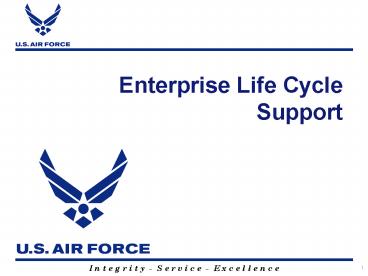Enterprise Life Cycle Support - PowerPoint PPT Presentation
1 / 11
Title:
Enterprise Life Cycle Support
Description:
I n t e g r i t y - S e r v i c e - E x c e l l e n c e. Integrated Lifecycle Management ... Disjointed incentives for process improvement and cost reduction across ... – PowerPoint PPT presentation
Number of Views:47
Avg rating:3.0/5.0
Title: Enterprise Life Cycle Support
1
Enterprise Life Cycle Support
2
Integrated Lifecycle Management SECAF Direction,
6 Jun 07
- Established Integrated Life Cycle Management
strategy - Requires integration of all life cycle management
functions (engineering, supplier management,
maintenance, etc) - Ensures seamless and increased transparency
- Mandates enterprise-level forums i.e. ILCM
Executive Forum - Enables closer relationship between organizations
critical to successful implementation of life
cycle mission - Enhances integrated leadership decisional
processes for requirements, technology,
acquisition, test, and sustainment - Provides strategic governances to sustain weapon
systems balancing resources with long-term
objectives
3
Current Approach to Product Support Decisions
Causes a Lack of Enterprise Integration
4
and drives unintended consequences risk
- Trend is to outsource product support skills
without knowledge of enterprise impact - Limits ability to reconstitute skill sets if
contractor failure - Loss of intellectual capital to manage enterprise
in sustainment phase (e.g., engineering) - Impacts ability to be a smart buyer and manager
of sustainment services across the life cycle - Complexity of system technology makes management
of product sustainment skills critical - Workload split controlled by contractor limits
flexibility to adjust funding and work mix to
meet readiness and legislative requirements - Core and 50/50 are maintenance centric does not
address product support skills and resources - 50/50 management is reaction-based
- Disjointed incentives for process improvement and
cost reduction across enterprise through best
practices and competition
Management of Product Support Critical Must
Retain Responsibilities to Hone and Preserve
Skills Sets
5
Trends
1950s
2010s
Commercial Based Aircraft Trainers Excluded
Above (All CLS)
For partnerships the majority of product support
activities are provided by the contractor and the
majority of the depot maintenance is done on
contract (except F-22 in out years)
6
Industry Lessons Learned Summary
- Formed IPT from Headquarters AF, ALCs, and AFMC
to Benchmarked Industry Toyota, American
Airlines, General Dynamics, Honeywell,
Caterpillar What we learned - No system level PBL constructs
- Retain engineering control and responsibility
- Retain in-house capability if sole source is the
only option - FAA certification of organic engineering and
repair capability for in house/outside customers
key to competitive advantage - Transparency of data Costs repair/manufacturing
details - Review supplier relationships every 2-3 years
- Flexible workforce
- Overall objectives shared with suppliers
- Reduce cost
- Reduce risk
- Added value to customer
- Industry Sourcing Model
7
Process Sourcing Decision Model (PSDM)AF Model
(Based on Industry Model)
8
ILCM-EF Direction
- Sep 07 ILCM-EF Tasks
- Develop construct for life cycle product support
strategy and CONOPS - Governance, policy, and metrics to implement
- Implementing guidance for process sourcing model
- Reassessment requirement of sourcing decisions
- Efforts To date
- Drafted template for strategy CONOPS for
initial comments - Approach for baseline manpower assessment
- Approach for governance
- Key PS areas defined consistent with other
efforts - Great comments back which are being incorporated
ILCM-EF Validation and Sustainment
SES IPT Strategic Assessment
Product Support Master Plan Development
SES IPT Analysis
Conduct Initial Assessment for Baseline
9
Integrated Product Support Strategy and CONOPS
- Integrated Life Cycle Management Enterprise
seamless governance, transparency and integration
- Requirements and acquisition strategy mix and
processes are congruent using an iterative
decision process - Retain product support integration skills
- Develop/execute enterprise strategy and CONOPS
for viable organic /contractor industrial base
flexibility to move workload to maximize
performance and retain intellectual capital - Enterprise sourcing decision process considering
cost and risk factors, maintains critical skill,
and legislative compliance - Enterprise health assessment of product support
functions - May require additional funding, workforce
realignments, and training to re-grow
competencies/skills
10
Notional GovernanceConstruct
SAE, AFMC/CC, SAF/IE, AF/A4/7,SAF/US, AFSPC/CV
Corporate AF
- Corporate Integration
- Decisions on Sustainment Capabilities
- Overall priorities policy
- Long Range Planning Strategies
PEOs, Product Center- ALC CCs
ILCM Exec. Forum
- Strategic and Operational Integration
- Strategic direction for Capabilities
- I LCM-wide implementation of initiatives,
polices and practices
GO / SES / PEO
Joint Product Support Council
Logistics Council
Logistics Exec Steering Group
Existing Acquisition Review Forums
- Tactical integration/execution
- Cross functional / cross process collaboration
- Financial business
- processes
Col/Chiefs
Independent Reviews
Other Working Groups
Depot MX Activation Working Groups
Weapon Sys Reviews
11
Keys to Success
- Enterprise Approach with Stakeholders Buy-In
- Applying the Resources POM, Manpower, Etc.
- Effective and Clear Governance Structure
- Communication Inside and Outside AF































